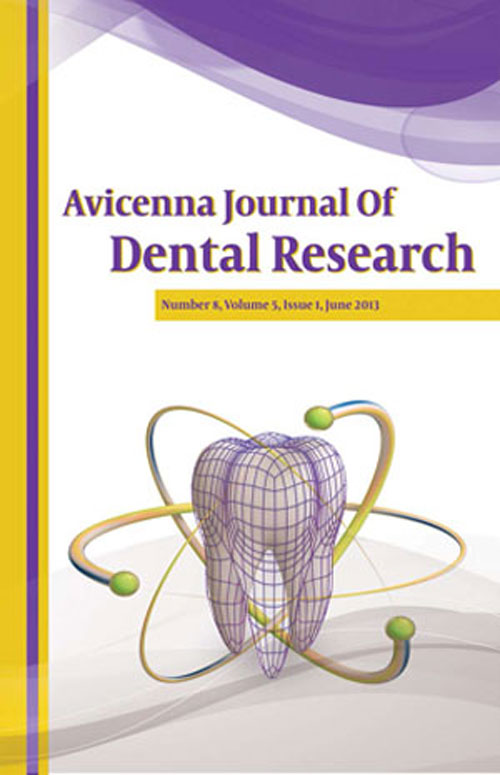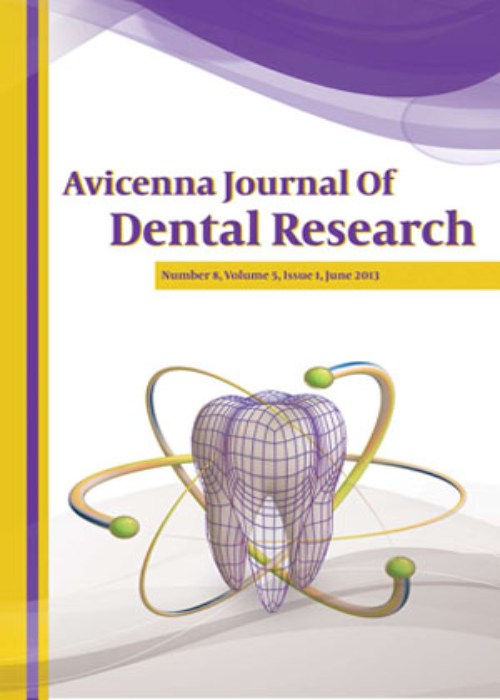فهرست مطالب

Avicenna Journal of Dental Research
Volume:7 Issue: 2, Dec 2015
- تاریخ انتشار: 1394/10/06
- تعداد عناوین: 7
-
-
Page 1Context: Although dental implant (DI) is an increasingly prevalent therapeutic approach in partial or complete edentulous patients, understanding the bone healing mechanisms and effective factors on it, is still necessary for us. The initial requirement in DI success rate is to achieve a proper wound healing, DI stability and desirable osseointegration, Thereby, assessment of all probable risk factors of DI treatment should be considered prior to a treatment plan.Evidence Acquisition: Literature searching was performed through electronic search in three data bases of MEDLINE, Google scholar and SCOPUS, and also manual search on available performed studies up to June 2013.ResultsThough, there are multiple technique-related or patient-related local and systemic factors, which may interfere with proper osseointegration or compromise the long-term implant prognosis. There are just few absolute contraindications for DI therapy such as IV bisphosphonate therapy and severe renal failure.ConclusionsThere are few absolute contraindications for DI treatment. As a whole, correct patient selection, and applying standard rules of surgical procedure and DI loading would lead to a successful DI treatment.Keywords: Dental Implants, Osseointegration, Contraindications
-
Page 2BackgroundSealing ability is an essential factor for retrograde filling material in successful endodontic apical surgery. The aim of this in vitro study was to evaluate dye microleakage of Mineral Trioxide Aggregate (MTA) and Calcium Enriched Mixture (CEM cement) as root end filling material.ObjectivesThe aim of this in vitro study was to compare sealing ability of these two root end filling materials using the dye penetration method.Materials And MethodsEighty-six single rooted teeth were randomly divided into two study (n = 40) groups and two positive and negative control (n = 3) groups. After decoronation closely to the cementum enamel junction, the root canals were shaped by the crown down technique and obturated by gutta-percha and AH26 sealer with the lateral condensation method. Furthermore, 3 mm of root ends were resected and 3 mm root-end cavities were prepared by ultrasonic microsurgical tip. Root-end cavities were filled with each of the mentioned materials. Methylene blue dye was used for determination of dye leakage. Chi-2 analysis and t-test were used to compare groups.ResultsThe mean apical penetration of dye in the MTA group was 0.94 mm while in the CEM cement group this was 1.17 mm. Eighty percent of the MTA group and 75% of the CEM cement group didn’t have any dye leakage. The P level was greater than 0.05 (0.592).ConclusionsThere was no significant statistical difference between MTA and CEM cement in sealing ability (P > 0.05).Keywords: Mineral Trioxide Aggregate, Calcium Enriched Mixture Cement, Dental Leakage, Root Canal Filling Materials
-
Page 3BackgroundA small number of malignant tumors occur during childhood and adolescence. The frequency of such tumors in these age groups is evaluated in only a few studies.ObjectivesWe aimed to determine the frequency of head and neck cancers in a population of Iranian children and adolescents.Patients andMethodsThe records of patients ≤ 19 years old, suffering from head and neck cancers, were reviewed in the pathology centers of Hamadan province from 1989 to 2009. Patients with central nervous system tumors, thyroid and melanoma were excluded. Data were collected based on age, sex and lesion location and statistical analysis was performed.ResultsAmong the study population (3368 cases of head and neck cancer), 75 cases (2.22%) belonged to children and adolescents aged between 0 - 19. The Mean ± SD age of the patients was 13 ± 5.6 (range: 2 months, 19 years). The most common cancers were non-Hodgkin’s lymphoma (23%), squamous cell carcinoma (SCC) (20%), and Hodgkin’s lymphoma (14.7%). Malignant oral and maxillofacial tumors account for only 18.7% of all head and neck tumors.ConclusionsCarcinomas were the most common malignant tumors of head and neck observed in this age group. Also, oral cancers in children and adolescents constitute a small percentage of the lesions that were studied.Keywords: Head, Neck, Cancer, Adolescents, Children
-
Page 4BackgroundDenture stomatitis is a very common oral mucosal lesion, affecting approximately 50% of denture wearers in some populations. More recently there is an increased interest to use natural antimicrobial compounds, like plant extracts of medicinal plants.ObjectivesThe aim of the present study was to evaluate the efficacy of green tea extract compared with nystatin drop in the treatment of denture stomatitis.Patients andMethodsThis was a clinical trial study with 30 patients in two parallel groups, 15 patients received nystatin drop and the other ones green tea extract. The patients in two weeks were recommended to use mouthwash 4 times a day each time 15 - 20 drops for 2 - 3 minutes and after that they should avoid eating and drinking for 30 minutes; patients in the two groups were suggested to use the drug at a specific time. Amount of inflammation and erythema were recorded in each session and measured with a graded blade and recorded according to a 6-point scale. At each visit, mycological samples were taken from the palatal mucosa for culture.ResultsAge and sex differences between the groups were not significant. The erythema surface of the palatal was significantly reduced in the both groups at follow-up visits compared with the pretreatment condition. No significant difference was seen between the two groups at the same visits in erythema surface and colony counts of the palatal mucosa (P > 0.05).ConclusionsThis study indicated that green tea extract can be effective in reducing the number of Candida colonies and erythematic area comparable to nystatin drop in the management of denture stomatitis.Keywords: Denture Stomatitis, Oral Candidiasis, Green Tea Extract, Medical Plants
-
Page 5BackgroundThe use of casting ring to produce accurate casting has been challenged with the introduction of a ringless casting technique. This study compared the vertical margin discrepancy of castings fabricated with the ringless technique, conventional (ring and liner) technique and conventional technique with hygroscopic expansion investment systems.ObjectivesThe current study aimed to determine and compare the mean values of vertical margin discrepancies of castings in three investing procedures: the ringless technique and conventional investing technique.Materials And MethodsIn the first step, 39 coping wax patterns for Porcelain fused to metal restoration (P.F.M). With chamfer finish line were fabricated on the metal die and then divided into three groups of 13. The first group used conventional investing (with ring and liner), the second group used the ringless technique and the third group used the conventional ring technique with liner and hygroscopic expansion. All groups were invested using Thermovest phosphate bonded investment. Then wax patterns were cast with Ni-Cr alloy (super cast). Castings were divested, cleaned and seated on the metal die after minimal internal surface adjustment. The vertical margin discrepancy was measured in four sites: on the buccal, lingual, mesial and distal surfaces of the die. Castings were measured on an optical microscope. The vertical margin discrepancy in each group was used for statistical analysis.ResultsAfter statistical evaluation, the following results were obtained: the mean vertical margin discrepancy for conventional investing was 156.72 ± 64.67µ; for the ringless technique it was 117.3 ± 26.77µ; and for the conventional metal ring technique with hygroscopic expansion it was 96.15 ± 38.31 µ. There is a significant difference between castings of the conventional investing technique and the ringless and ring plus hygroscopic expansion techniques (P < 0.001). No significant difference was found between the ringless and ring plus hygroscopic expansion techniques (P = 0.183).ConclusionsThe castings fabricated from the ringless technique with non-precious alloy are acceptable. This investing system is useable for the fabrication of fixed restorations.Keywords: Ringless Investment System, Dental Casting, Vertical Margin Discrepancy, Hygroscopic Expansion
-
Page 6BackgroundUsing a reliable indicator to identify different phases of skeletal maturation is an important issue in orthodontic diagnosis and treatment planning.ObjectivesThe aim of this study was to evaluate the correlation between stages of tooth calcification and cervical vertebral maturation in Iranian individuals.Patients andMethods216 digital panoramic and lateral cephalometry of healthy patients, 99 males and 117 females (aged 8 to 16 years) seeking orthodontic treatment included in the study. To determine dental maturational stage, calcification of the mandibular canine, the first and second premolars and the second molar were assessed according to the method suggested by Demirjian et al. To evaluate the stage of skeletal maturation, cervical vertebral morphologic changes were assessed on lateral cephalometric radiographs according to the method suggested by Baccetti et al. All radiographs were evaluated by two observers and inter- and intra-examiner reliability were examined. Spearman’s correlations coefficients were calculated to establish the association between cervical vertebral maturation and teeth calcification. P-values less than 0.001 were considered statistically significant.ResultsAll correlation values obtained were statistically significant (P < 0.001). Correlations between dental development and skeletal maturity stage due to CVM method ranged from 0.76 to 0.77 (P < 0.001) for females and 0.63 to 0.71 (P < 0.001) for males. The second molar (0.77) and second premolar (0.71) presented the highest correlation for female and male subjects, respectively.ConclusionsThe relationship between calcification of tooth and maturation of cervical bones was significant. This suggested that tooth calcification stages from panoramic radiographs might be clinically useful as a maturity indicator.Keywords: Cervical Vertebrae, Cephalometry, Radiography, Panoramic, Tooth Calcification
-
Page 7IntroductionExfoliative Cheilitis (EC) is a rare chronic inflammatory condition affecting the vermillion border of the lips and characterized by excessive production of keratin. In this paper, a case of chronic EC that was relatively resistant to usual treatment is to be introduced. Also, we explain its clinical course and treatment procedures and measures.Case PresentationWe report a 25-year-old Iranian woman presented with desquamation of her lips. History, clinical feature and histopathological examination revealed a diagnosis of EC.ConclusionsAlthough treatment of EC in the present study had considerable success in the short-term follow-up, it should be noted, due to the unknown of the exact cause, no specific treatment or protocol has still been identified..Keywords: Cheilitis, Lip, Case Report


